Bitcoin
Is Bitcoin Doomed Without an Urgent Green Blockchain Upgrade?
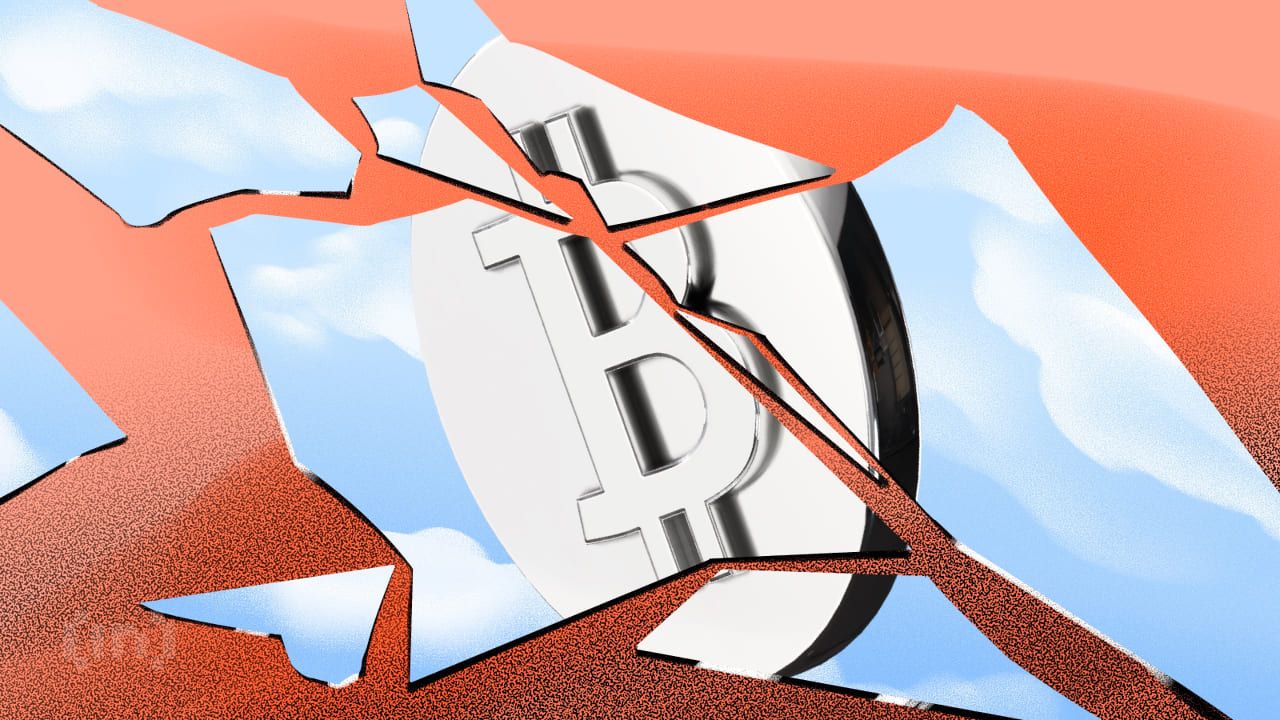
The debate over cryptocurrencies’ environmental impact has intensified as governments, corporations, and investors focus on Environmental, Social, and Governance (ESG) concerns. Bitcoin, the world’s most prominent cryptocurrency, is leading the criticism, known for its energy-intensive Proof-of-Work (PoW) consensus mechanism.
While innovations are emerging across the crypto industry to address environmental concerns, Bitcoin’s contribution to global carbon emissions remains a major point of contention.
Bitcoin’s Environmental Problem
Bitcoin’s PoW mechanism relies on miners solving complex cryptographic problems, consuming vast amounts of computational power and energy.
According to estimates from the University of Cambridge, Bitcoin’s annual energy consumption rivals that of entire nations such as Argentina or Norway. Moreover, Bitcoin’s environmental footprint is exacerbated in regions where mining operations are powered by non-renewable energy sources.
“Bitcoin mining may be responsible for 65.4 megatonnes of CO2 (MtCO2) per year, which is comparable to country-level emissions in Greece (56.6 MtCO2 in 2019) and represents 0.19% of global emissions,” a report titled Revisiting Bitcoin’s Carbon Footprint read.
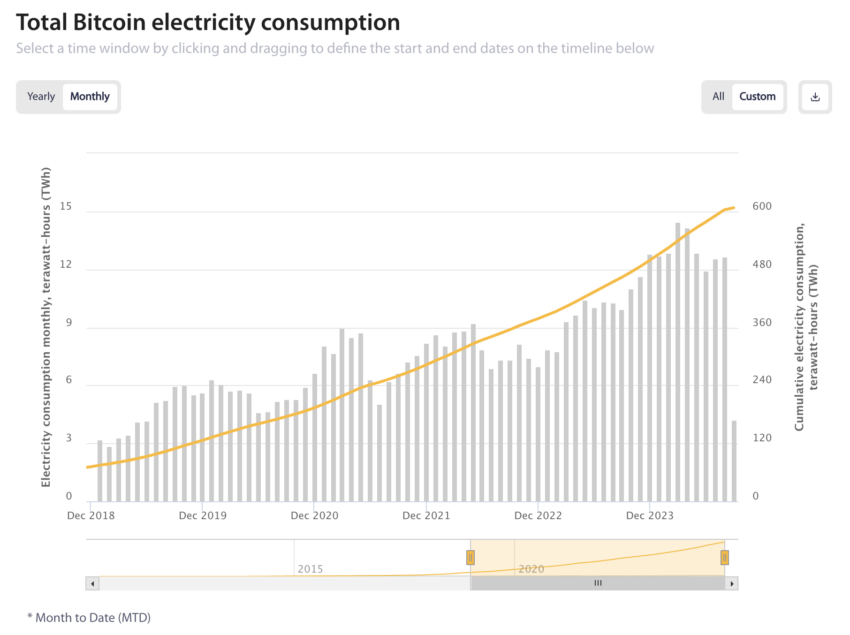
Critics argue that this consumption is disproportionate and unsustainable, especially in light of global climate commitments. While alternative cryptocurrencies are exploring eco-friendly mechanisms, Bitcoin’s slow adaptation to such technologies has raised concerns.
“Everybody recognizes Bitcoin is environmentally unhealthy, but any big changes to Bitcoin protocol have been very unsuccessful because you need to get all the miners to agree on that,” Hanna Halaburda, Associate Professor of Information at NYU Stern School of Business, said.
If environmental sustainability becomes a core expectation of investors and regulators, Bitcoin may soon face increasing pressure to upgrade.
A Green Shift in Crypto
In contrast to Bitcoin, other blockchain platforms have already taken steps to reduce their environmental impact. Ethereum, for instance, made headlines in 2022 with its shift from PoW to Proof-of-Stake (PoS), cutting its energy consumption by over 99%. PoS replaces energy-hungry mining with validators who lock up tokens as collateral to secure the network.
This transformation set a precedent for the industry, showing that eco-friendly upgrades are possible even in established networks.
Read more: Proof of Work and Proof of Stake Explained
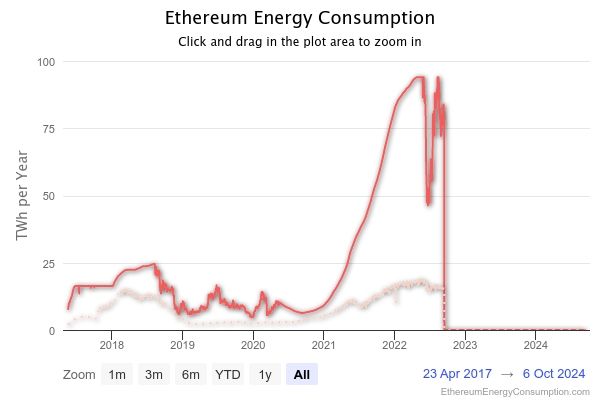
Other platforms like Hedera, Cardano, and Tezos also boast PoS mechanisms and are increasingly focusing on sustainability. Hedera’s involvement in carbon offsetting projects and its collaboration with the Global Blockchain Business Council (GBBC) to promote environmental standards are further steps toward reducing blockchain’s ecological footprint.
In an exclusive interview with BeInCrypto, Wes Geisenberger, Vice President of Sustainability and ESG at HBAR, noted the importance of the GBBC InterWork Alliance’s Carbon Emission Token (CET) Task Force. This task force, developed to address carbon accounting at a technical level, is helping companies navigate these regulations.
“The CET is a positive contribution, very much driven by the changes coming from governments and corporates looking for solutions to credibly address their environmental impact,” Geisenberger said.
This kind of technical development highlights the growing intersection of blockchain and environmental governance. The crypto industry is increasingly collaborating with government bodies and international organizations to find solutions that meet regulatory expectations while leveraging blockchain’s potential to innovate.
Investors are Paying Attention
Investor sentiment is increasingly aligned with global ESG priorities. Climate-conscious investors are urging industries, including crypto, to take accountability for their environmental impact. In response, some blockchain ecosystems are leading climate-focused efforts, both through technological innovation and by funding sustainable projects.
According to Geisenberger, the HBAR Foundation’s Sustainable Impact Fund is one of the first grant-based funds aimed at promoting blockchain’s role in sustainability. This fund supports initiatives like the Hedera Guardian, a public ledger platform designed to improve transparency in carbon credit markets.
By enabling institutions and startups to track and verify their carbon-offsetting efforts, Hedera has shown how blockchains can facilitate responsible environmental practices.
“The Hedera Guardian has already onboarded 500 million metric tonnes of carbon credits. We see these tools helping answer challenges to enable outcomes to measure our planet’s externalities and give agency to folks participating in environmental and biodiversity projects to better trace flows of funds back to the community,” Geisenberger explained.
Despite these positive developments in the broader blockchain ecosystem, Bitcoin’s reliance on PoW remains unchanged. Bitcoin advocates argue that its decentralized nature and security features are unparalleled and that any shift in its consensus mechanism could jeopardize its integrity. They point to Bitcoin miners’ adoption of renewable energy as a possible solution to its environmental challenges.
Some mining operations are indeed migrating to regions with abundant hydroelectric, wind, and solar power. However, these efforts are still piecemeal and lack industry-wide coordination.
“A lot of Bitcoin mining companies have set up their contracts with renewable energy companies. The argument is that having these mining facilities as clients means that when there’s an oversupply of energy, it may actually make it more profitable for the renewable energy plants,” Halaburda added.
Read more: 5 Best Platforms To Buy Bitcoin Mining Stocks After 2024 Halving
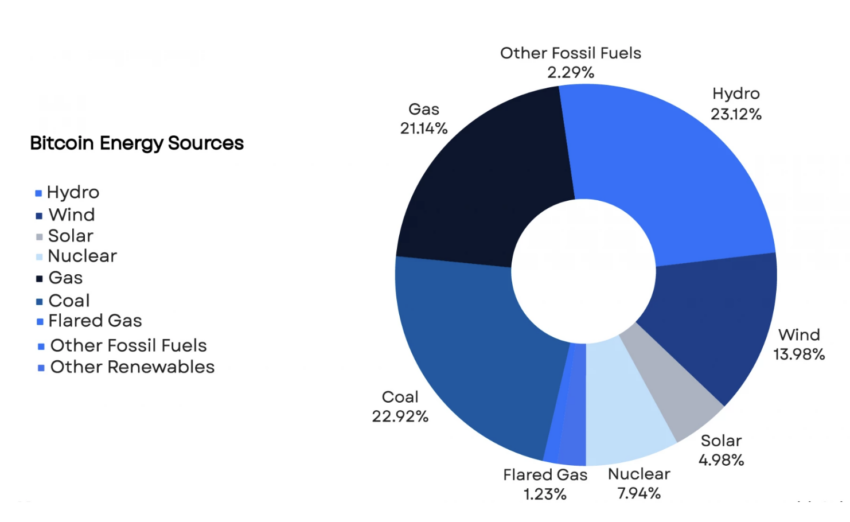
The question, then, is whether Bitcoin will be able to evolve in an increasingly ESG-driven world. The industry’s focus on renewable energy and carbon offsetting projects offers some hope, but it may not be enough if regulatory frameworks impose stricter environmental requirements.
Challenges in Standardizing ESG Metrics
While some crypto platforms have made strides toward sustainability, the challenge of standardizing ESG metrics across the industry persists. Blockchain technology’s decentralized and often opaque nature complicates the task of measuring environmental impact consistently and comparably.
Efforts like the CET protocol are helping to fill this gap, but broader industry-wide adoption is necessary for meaningful change. Without standardization, it remains difficult to gauge which platforms are truly sustainable and which are relying on surface-level commitments.
There is also the challenge of balancing the interests of investors, users, and environmental advocates, each of whom has different expectations regarding the future of blockchain technology.
As regulations tighten and the global push for sustainability accelerates, Bitcoin’s environmental footprint will likely become harder to ignore. The crypto industry has demonstrated that it can innovate and adapt, but Bitcoin, as the original and most influential cryptocurrency, faces an uphill battle. It may ultimately require either an upgrade in its consensus mechanism or a significant investment in renewable energy solutions.
Disclaimer
Following the Trust Project guidelines, this feature article presents opinions and perspectives from industry experts or individuals. BeInCrypto is dedicated to transparent reporting, but the views expressed in this article do not necessarily reflect those of BeInCrypto or its staff. Readers should verify information independently and consult with a professional before making decisions based on this content. Please note that our Terms and Conditions, Privacy Policy, and Disclaimers have been updated.
Bitcoin
Lummis Confirms Treasury Probes Direct Buys


In an interview with Bitcoin commentator Natalie Brunell, Senator Cynthia Lummis (R-WY) reaffirmed her commitment to establishing a US Strategic Bitcoin Reserve (SBR), disclosing that the Treasury Department is probing its legal authority to purchase and custody BTC on behalf of the federal government. The senator believes such a move could significantly reduce the national debt over the long term.
Senator Lummis Pushes Bitcoin Reserve
Lummis pointed to roughly 200,000 BTC in the US Marshals Service’s asset forfeiture program as a possible starting point: “Working with Treasury, and the Treasury Secretary, we’re trying to find out which assets among those could become the basis of the first year’s investment in a strategic Bitcoin reserve.”
Further clarifying her stance, the senator noted she is determining whether a new law is required or if the administration already has the authority: “What I’m trying to figure out right now is whether it needs to be done legislatively or whether the Treasury Secretary has the authority to do it right now.”
Lummis proposes converting the seized BTC into an official “base investment,” which she says would be the foundation of a larger BTC reserve. If successful, this would mark the first time the US government deliberately and openly accumulated Bitcoin as a strategic asset.
One of Lummis’ main arguments for a SBR is its capacity to trim the federal debt, which she deems “irresponsibly high.” Under her Bitcoin Act, the US could also revalue its gold certificates—currently listed at a decades-old official price of $42 per ounce, far below market value—and deploy the difference toward purchasing BTC in a budget neutral way:
“My legislation would provide that we could take our gold certificates… bring them up to current fair market value for gold and then use that to buy Bitcoin, thereby creating a 1 million Bitcoin reserve over five years.”
She contends that holding this million BTC over a 20-year horizon could “cut the current national debt in half.” Citing extensive modeling—some from advocates like Michael Saylor—she believes the price appreciation of BTC has the potential to deliver significant gains to taxpayers.
New Episode Out Now! 🇺🇸
U.S. Senator Cynthia Lummis is leading the Bitcoin Revolution in Washington.
Her bold plans for America through Bitcoin & digital asset policy promise to reshape the financial system—reduce U.S. debt, protect Bitcoin self-custody, and reinforce dollar… pic.twitter.com/G1Rvl1ORDb
— Natalie Brunell ⚡️ (@natbrunell) April 1, 2025
The senator lauded President Trump’s recent executive orders that aim to make the United States “the digital asset capital of the world” by fostering a favorable environment for BTC mining, regulatory clarity, and a strategic reserve. According to Lummis, those moves stand in stark contrast to prior administrations, where “people neither knew nor wanted to talk about digital assets.”
However, Lummis also underscored the need for bipartisan collaboration, suggesting that while Bitcoin has now garnered interest in Republican circles, it should not become a strictly partisan endeavor: “We want to keep that momentum… We worked extremely hard to keep it bipartisan, so I can’t flip my brain and start to think of it as a partisan issue.”
At press time, BTC traded at $84,202.

Featured image from YouTube, chart from TradingView.com

Editorial Process for bitcoinist is centered on delivering thoroughly researched, accurate, and unbiased content. We uphold strict sourcing standards, and each page undergoes diligent review by our team of top technology experts and seasoned editors. This process ensures the integrity, relevance, and value of our content for our readers.
Bitcoin
Tokenized Gold Market Cap Tops $1.2 Billion as Gold Prices Surge

The market cap of tokenized gold has surpassed $1.2 billion, driven by soaring gold prices and a growing appetite for blockchain-based assets.
Rising interest in tokenized gold is part of a broader movement to modernize storage, trading, and utilization in financial markets.
Gold Meets Blockchain Amid Tokenization Revolution
Gold price has reached historic highs above $3,000 per ounce. With this surge, digital representations of precious metals, such as Tether Gold (XAUT) and Paxos Gold (PAXG), capture investor interest.
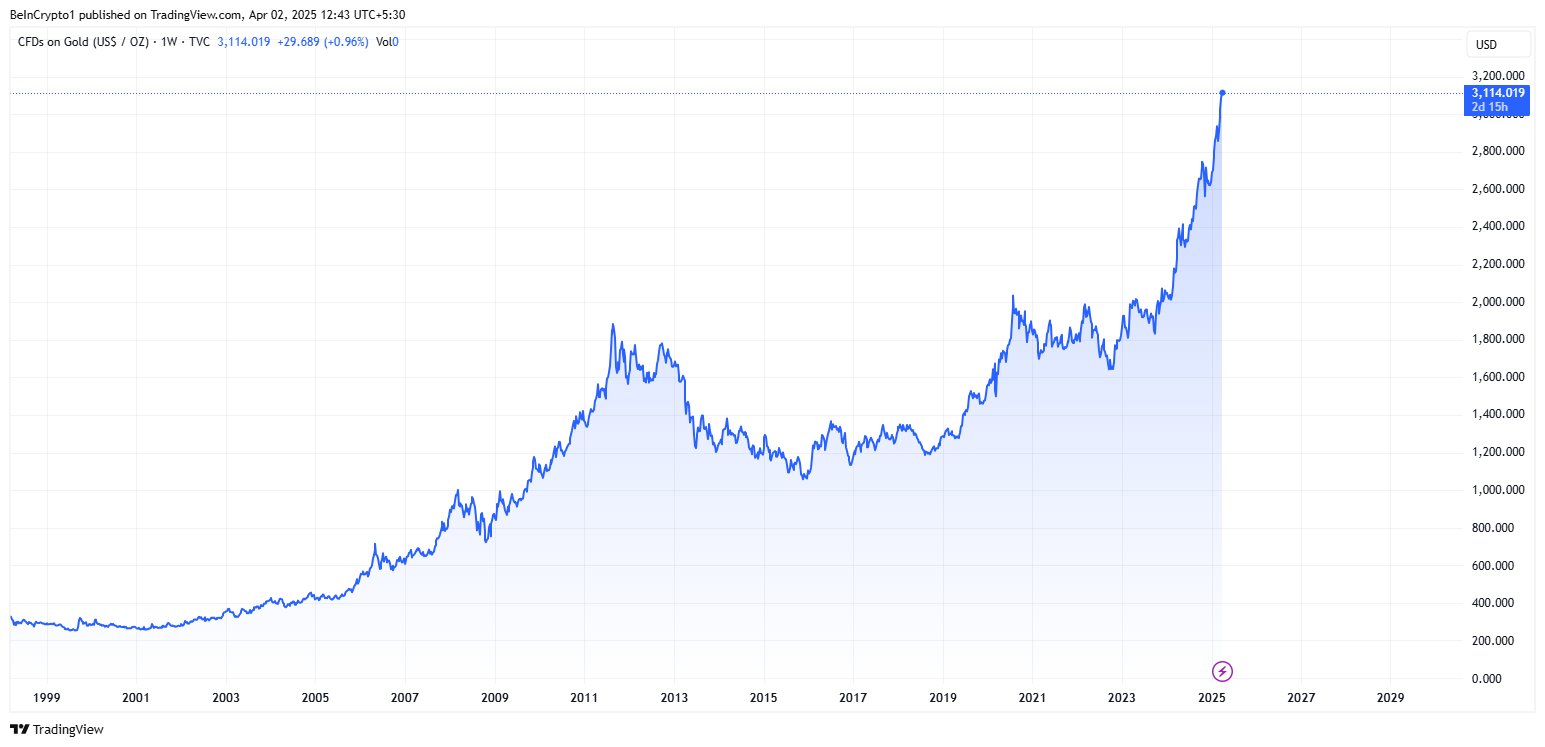
Don Tapscott, co-founder of Blockchain Research Institute, argues that tokenized gold could transform the $13 trillion gold market by bringing transparency, liquidity, and new financial models.
Based on this assumption, he questioned why gold is still stored in vaults as it was in the 1800s. Meanwhile, assets like Bitcoin (BTC) and stablecoins have gone digital. He believes blockchain technology can revolutionize gold’s role in finance.
“The US government could even tokenize its gold reserves, track them immutably, and use them in innovative ways,” Tapscott explained.
He stated that such an outcome would enable fractional ownership, on-chain verification, and increased accessibility to investors worldwide.
Meanwhile, companies such as Paxos and Tether lead the charge in tokenized gold offerings. Paxos holds a 51.74% market share, while Tether’s holdings follow closely behind at 46.69%.
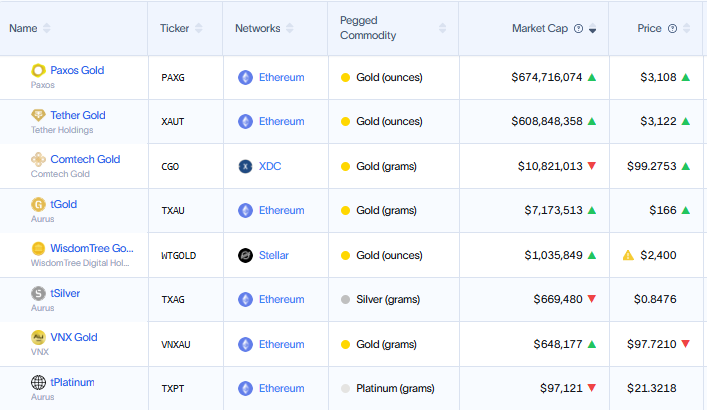
Publicly listed Matador Technologies is taking a unique approach by tokenizing gold on the Bitcoin blockchain. This offers investors a digital claim on both physical gold and limited-edition digital art.
“We believe that the next generation of financial powerhouses will likely emerge from the tokenization revolution. It’s still early, and the playing field is wide open. Matador and others have the bull by the horns,” Tapscott noted in a recent article.
Gold Tokenization in the US: A Bold Policy Shift?
The momentum behind tokenized gold has also reached the US government. Following President Trump’s March 5 executive order to establish a Strategic Bitcoin Reserve (SBR), policymakers are exploring ways to modernize gold holdings.
Treasury Secretary Scott Bessent has indicated that the US will move to “monetize its assets,” leading some to speculate that Fort Knox gold could be tokenized.
“US Treasury Secretary Scott Bessent says, all the GOLD is there, as he has no plans to visit Fort Knox or to revalue GOLD reserves in a sovereign wealth fund. He speaks on “Bloomberg Surveillance,” Erik Yeung noted.
Senator Cynthia Lummis has also proposed swapping some of the US government’s gold reserves for Bitcoin. US gold reserves are held at a book value of $42 per ounce—unchanged since 1973—despite the market price exceeding $3,000 per ounce.
While the US explores tokenization, geopolitical rivals China and Russia may take an even bolder step—launching a gold-backed stablecoin. Bitcoin maximalist Max Keiser recently highlighted BRICS’ plans to introduce a gold-backed stablecoin.
“The BRICS, principally Russia, China & India, will counter any attempt by the US to introduce a hegemonic, USD-backed stablecoin — with a Gold-backed stablecoin. The majority of the global market will favor a Gold-backed coin since it’s inflation-proof (unlike the USD) and doesn’t boost unwelcome US hegemony. India already runs on a defacto Gold standard and Sharia law in Muslim countries would dictate Gold over a USD riba-coin as well. To be clear, a BTC-backed stablecoin is not fit for purpose due to volatility,” Keiser stated.
Further, Keiser suggested that a stablecoin backed by gold would outcompete USD-backed stablecoins in global markets. He argues that gold is more trusted than the US dollar, tracks inflation effectively, and remains minimally volatile compared to Bitcoin’s price swings.
Russia’s recent rejection of Bitcoin for its National Wealth Fund in favor of gold and the Chinese yuan adds weight to this theory.
With an estimated 50,000 tonnes of combined gold reserves, China and Russia could leverage blockchain technology to introduce a new gold-backed digital asset. Such an action would challenge the US dollar’s dominance in global trade.
Gold vs. Bitcoin: The Safe Haven Debate Intensifies
Gold’s record-breaking rally has reignited debates over its role as a safe-haven asset compared to Bitcoin. Some analysts speculate that Bitcoin could soon follow gold’s trajectory, setting new all-time highs.
However, in economic uncertainty and President Trump’s 2025 tariff policies, gold remains the preferred safe-haven asset. Historically, gold has been the go-to store of value during trade wars and inflationary periods. Meanwhile, Bitcoin’s volatility raises concerns for risk-averse investors.
Despite these differences, the rise of tokenized gold highlights a convergence between traditional and digital finance. As financial markets advance and investors rebalance their portfolios, gold and Bitcoin will likely coexist in a contemporary monetary system.
Whether through tokenization, gold-backed stablecoins, or government-led blockchain initiatives, the financial playing field is shifting.
As traditional institutions increasingly adopt blockchain, the stage is set for transforming how the world perceives, trades, and stores gold relative to Bitcoin.
Disclaimer
In adherence to the Trust Project guidelines, BeInCrypto is committed to unbiased, transparent reporting. This news article aims to provide accurate, timely information. However, readers are advised to verify facts independently and consult with a professional before making any decisions based on this content. Please note that our Terms and Conditions, Privacy Policy, and Disclaimers have been updated.
Bitcoin
Institutional Risk Aversion Drives $218 Million Bitcoin ETF Outflows

Bitcoin ETFs (exchange-traded funds) continue to record negative flows this week as President Trump’s Liberation Day countdown continues.
Sentiment is cautious across crypto markets, with traders and investors adopting a wait-and-see approach.
Bitcoin ETF See Outflows Amid Investor Caution
Data on Farside Investors shows two consecutive days of net outflows for Bitcoin ETFs since Monday. Financial instruments from Bitwise (BITB), Ark Invest (ARKB), and WisdomTree (BTCW) were in the frontline for Monday’s $60.6 million outflows, with only BlackRock’s IBIT seeing positive flows.
Meanwhile, Tuesday saw even more outflows, approaching $158 million, with Bitwise and Ark Invest leading the charge. Then, on April 1, BlackRock’s IBIT recorded zero flows. Meanwhile, Ethereum ETFs recorded net outflows of $3.6 million, data on Farside shows. This suggests a cautious sentiment among institutional investors.
“The Spot Bitcoin ETFs saw $157.8 million outflow yesterday. The Spot Ethereum ETFs saw a $3.6 million outflow. Institutions are reducing risk ahead of today’s tariff announcement,” analyst Crypto Rover noted.
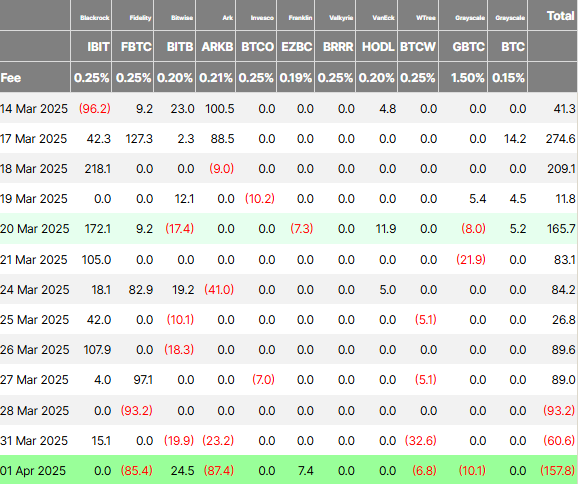
Indeed, sentiment suggests traders are exercising caution, choosing to remain in “wait-and-see” mode. The caution comes ahead of Trump’s Liberation Day announcement, which is due later in the day on April 2.
With POTUS poised to unveil sweeping new tariffs, traders and investors across financial playing fields wait to see the scope of an onslaught that could spark a global trade war. Specifically, there is generally very little information about the tariffs’ specifics, which creates uncertainty regarding their impact on the broader economy and the crypto market.
“The White House has not reached a firm decision on their tariff plan,” Bloomberg reported, citing people close to the matter.
Despite the lack of clarity, it is understandable why investors would be cautious considering the impact of previous tariff announcements on Bitcoin price. Meanwhile, analysts predict extreme market volatility, with potential stock and crypto crashes reaching 10-15% if Trump enforces broad tariffs.
“April 2nd is similar to election night. It is the biggest event of the year by an order of magnitude. 10x more important than any FOMC, which is a lot. And anything can happen,” economic analyst Alex Krüger predicted.
While sentiment is cautious in the crypto market, some investors are channeling toward gold as a safe haven. A Bank of America survey showed that 58% of fund managers prefer gold as a trade war safe haven, while only 3% back Bitcoin.
These findings came as institutional investors cite Bitcoin’s volatility and limited crisis-time liquidity as key barriers to its safe-haven adoption. Trade tensions have historically driven capital into safe-haven assets.
With Trump’s Liberation Day announcement looming, investors preemptively position themselves again, favoring gold over Bitcoin.
Nevertheless, despite Bitcoin’s struggle to capture institutional safe-haven flows, its long-term narrative remains intact. This is seen with Bitcoin supply on exchanges dropping to just 7.53%, the lowest since February 2018.
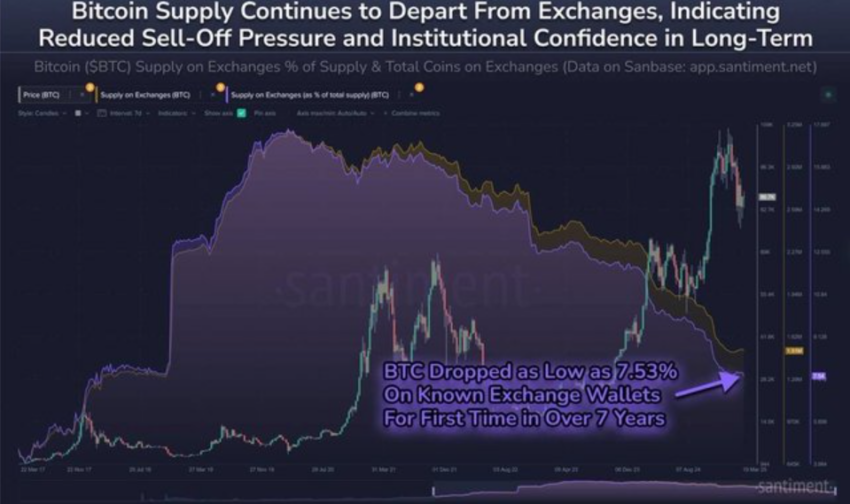
When an asset’s supply on exchanges reduces, investors are unwilling to sell, suggesting strong long-term holder confidence.
Disclaimer
In adherence to the Trust Project guidelines, BeInCrypto is committed to unbiased, transparent reporting. This news article aims to provide accurate, timely information. However, readers are advised to verify facts independently and consult with a professional before making any decisions based on this content. Please note that our Terms and Conditions, Privacy Policy, and Disclaimers have been updated.
-

 Altcoin22 hours ago
Altcoin22 hours agoXRP Price to $27? Expert Predicts Exact Timeline for the Next Massive Surge
-

 Altcoin24 hours ago
Altcoin24 hours agoBinance Update Sparks 50% Decline For Solana Meme Coin ACT: Details
-

 Market21 hours ago
Market21 hours agoEthereum Struggles to Break Out as Bear Trend Fades
-

 Market20 hours ago
Market20 hours agoHow Did UPCX Lose $70 Million in a UPC Hack?
-

 Market24 hours ago
Market24 hours agoBitcoin Stuck in Place as Tariffs and Charts Point Both Ways
-

 Market22 hours ago
Market22 hours agoBinance Megadrop Launches KernelDAO
-

 Market12 hours ago
Market12 hours agoBitcoin Price Bounces Back—Can It Finally Break Resistance?
-

 Market19 hours ago
Market19 hours agoHill Rejects Interest-Bearing Stablecoins Despite Armstrong’s Wish





















